 |
| The First People
of the Americas |
The northern part of North America that today is known as Canada
was far from being a "vast empty land" when the first white
people arrived. It was inhabited from the Atlantic to the Pacific
by people who were mistakenly called Indians by the European
explorers. They had lived in North America for many millenia.
These original inhabitants also had elaborate and varied lifestyles
and customs which had evolved through long adaptation to their
particular environments. Though the population was small, with
estimates varying from 500,000 to 2,000,000, the use of the
land was more extensive than those figures indicate. The mobile
hunting and gathering way of life of most of Canada's First
Nations was land-intensive and thus required continuous movement
in search of new resources.
Of the two main regions where sedentary societies developed,
the Northwest Coast had by far the highest population because
of its rich sea and rain-forest resources. In fact, it was the
most densely settled areas in the world for non-agricultural
peoples. The other region was southern Ontario, where the climate
and fertile soil allowed for farming.
Across Canada, more than 50 languages were spoken; these have
been classified into 12 families, half of which were spoken
only in British Columbia. By far the most widespread were (and
still are) Cree, in the Algonkian group, and Inuktitut, an Eskaleut
language of the Arctic.
Environment and Diversity
The living conditions imposed by the geographical regions --
Arctic, Subarctic, Northeastern Woodlands, Great Plains, Plateau
and Northwest Coast -- encouraged a variety of lifestyles. Northwest
Coast society, with its secure economy, developed hierarchical
chiefdoms in which chiefs, nobles and commoners were classed
according to wealth and heredity.
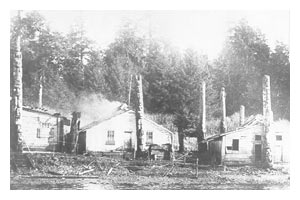
Haida village on the West
Coast |
This was particularly evident among northern groups, such as
the Tlingit, Haida and Tsimshian. Outside these classes were
the slaves, usually prisoners of war, but sometimes persons
who had lost their status, often because of debt. In any event,
they had no rights at all. The Salish to the south and in the
interior, placed less emphasis on rank and wealth; however,
there was much variation between groups. In general, the most
elaborate ceremonial life in aboriginal Canada was found on
the West coast and was closely connected with distinctive arts.
These are today the most widely represented of Native art in
museums anywhere.
Hunting/farming peoples included the various branches of Iroquoians,
as well as some Algonkian Odawa (Ottawa) of the St. Lawrence
Valley and Great Lakes regions. On the eastern seaboard were
the Algonkian Abenaki, "People of the Dawn", mainly in New England,
but also in the St. Lawrence Valley. The best known are the
Hurons and the Iroquois, both of whom formed confederacies that
played important roles in early contacts with Europeans. Hurons,
Iroquois and Abenaki lived in fenced villages, grew crops of
corn, beans and squash sown together -- the famous "three sisters."
Some of the Huron group specialized in growing tobacco. These
settlements were only as permanent as local resources allowed
-- when land, firewood and/or game became exhausted, the villagers
moved to new locations. These relocations took place every ten
to 50 years.
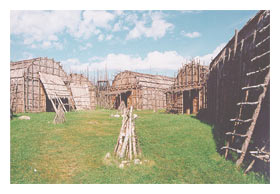
A Huron village (reconstruction) |
The Hurons, at the southeast corner of Lake Huron, were seated
at a north/south crossroads in the trade networks that criss-crossed
Aboriginal North America. They were the leading traders of the
north, exchanging agricultural products for products of the
hunt. Immediately south and to the east of Lake Ontario, the
Five Nations (later the Six Nations) controlled major routes
from the Atlantic coast to the interior. This was destined to
become an important factor in colonial politics as European
settlements spread westward.
All the other peoples who inhabited Canada were mobile hunters/gatherers.
They had thinly spread populations with simple social organization,
but possessed an intimate knowledge of the land and its resources.
Like the people of the Northwest Coast, those of the Gulf of
St. Lawrence, the Atlantic Coast and the Arctic were as skilled
hunters on the sea as they were on land.
Whatever the pattern of their lives, and despite its simplicity
in material terms, these peoples led satisfying social lives
within a framework of a complex spirituality. Their worldview
saw all living beings as related. Humans were part of a larger
order that depended on a balance of forces to keep the universe
functioning in an orderly and harmonious manner. Helping to
maintain this balance by means of rituals, ceremonies and taboos
was a deeply felt responsibility.
Contacts and Relationships
Current archaeological evidence indicates the presence of humans
in the Americas since at least 36,000 years ago; geology tells
us that human habitation has been possible for about 50,000
years. These dates apply to the non-glaciated areas of the Americas.
Because most of Canada was under ice until about 10,000 BC,
its occupation in general is more recent. However, the Yukon,
which escaped glaciation, has yielded evidence of human habitation
for 24,000 years, and some would push that date back to 40,000
years ago. Latest arrivals were the Inuit, who came from the
west about 1000 A.D. and reached the Atlantic coast during the
15th century.
The first recorded contacts between Europeans and Native North
Americans occurred in the Arctic, with the arrival of the Norse
about 1000 A.D. on Baffin Island and down the Atlantic coast.
Two of the aboriginal peoples most likely to have been affected,
Dorset and Beothuk, have since disappeared. The Arctic Dorset
came before the Inuit, and were displaced by them; the Beothuk
were a proto-Algonkian people inhabiting Newfoundland. Practically
nothing is known about these early encounters. That the men
of stone and bone held their own against the men of iron in
pre-firearm days is suggested by the short stay of the Norse
on continental America: the settlement they attempted in northern
Newfoundland may have lasted as long as six decades.
Contact continued sporadically until the 16th century, when
Europeans began to exploit the North Atlantic fisheries (the
term included sea mammal hunting). At the time, Inuit whaling
technology was the most advanced in the world. When combined
with European deep-sea ships, the result was the expansion of
whaling into a world-wide industry, with Aboriginal harpooners
playing a central role. Exploiting the cod fisheries involved
much less contact with Native inhabitants, as apart from establishing
shore stations for drying fish, the ships worked off-shore.
The fur trade, which began as a side activity from fishing,
called for a much closer relationship. It has been estimated
that by the time actual European settlement began early in the
17th century, as many as 1,000 ships a year were fishing and
trading in the Gulf of St. Lawrence and along the North Atlantic
coast.
While this activity brought benefits, it also brought misunderstandings.
The Beothuk, for instance, did not develop a working relationship
with Europeans; uneasy tolerance gave way to hostilities, which
in turn degenerated into an open feud. The last known Beothuk
died in 1829.
Another people who disappeared were the St.Lawrence Iroquoians,
although this time Europeans were not directly involved. Jacques
Cartier, on his second voyage to Canada, 1535-1536, found farming/fishing
villages scattered along the north shore of the river from the
Gulf of St Lawrence to Hochelaga (Montreal). When Samuel de
Champlain arrived on the scene in 1608, not one village remained.
What happened may have been a continuation of events already
in play before the arrival of Europeans; archaeology suggests
major population shifts had occurred over the centuries.
Partners in Trade and
War
Trading networks counterbalanced nature's uneven distribution
of resources. As trade could only be conducted with friends,
or at the very least under the protection of a truce, much diplomatic
protocol was involved. This gave great importance to alliances
and treaties, based on kinship and reciprocity. Exchanges had
to be evenly balanced: "I give to you that you might give to
me." Rituals, often elaborate, sealed commitments. When Europeans
entered into the trading system, they found they had to conform
if they expected to participate.
The spread of the fur trade and the Europeans' rapid penetration
of the interior would not have been possible without the help
of the first peoples, whose knowledge made these enterprises
easier to accomplish. Inuit, Innu (Montagnais and Naskapi),
Mi'kmaq and Maliseet were the first Canadian Aboriginal peoples
to come into lasting relationships with Europeans. However,
it was the Hurons who became the most famous of the French fur
trade partners, even though their alliance was brief: it began
with Champlain's visit to Huronia in 1615, and ended in 1649,
when the Five Nations dispersed the northern confederacy. European
trade may have helped to intensify pre-existing hostilities
between the two confederacies.
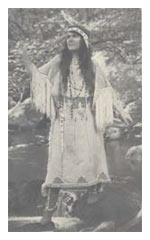
Abenaki |
Amerindians also played a vital role in the colonial wars between
Great Britain and France. The principal allies of the French
were the Abenaki, who were the Indians in the " French and Indians
" of border warfare (1757-63). Others who fought for the French
were the closely related Mi'kmaq and Maliseet, as well as some
Algonquins. The British were allied with the Five Nations. Two
major conflicts that involved Canada were the Iroquois War and
the Mi'kmaq War. The first lasted a century until peace was
signed in Montreal in 1701. The Mi'kmaq War was fought off and
on as a series of raids from early contact until the final defeat
of the French in 1760. The last of the colonial wars was that
of 1812-1814, a sort of postscript to the American War of Independence.
A spin-off from these hostilities, particularly from the War
of Independence, was a splitting of the Six Nations, as members
divided over which side to support. Those who fought for the
British, particularly the Mohawk, lost their traditional lands.
They resettled in southern Ontario, on land purchased for them
by the British from the Mississauga, a branch of the Ojibwa.
There the League of the Six Nations reconstituted itself; today
it is the largest of Canada's 607 bands.
The end of the colonial wars also saw the end of active Amerindian/European
partnership. Amerindian services were no longer needed for war,
nor were they needed in exploration as the British were now
established coast to coast. The fur trade was losing its economic
dominance to lumbering and agriculture, neither of which depended
upon Indian skills. In addition, European immigration had become
a flood; it has been estimated that already by 1812, Amerindians
in Upper Canada (Ontario) counted for only 10 % of the population.
Their declining numbers, which had begun with introduced diseases
from Europe, continued until well into the 20th century, giving
rise to the myth of the "Vanishing Indian." The trend has now
reversed, and Aboriginal nations are the most rapidly growing
segment of Canada's peoples. They are now estimated at 1.2 million,
4.3 % of Canada's population.
Shrinking Resources
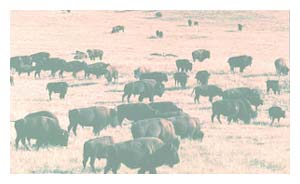
Millions of Buffalos roamed
the western prairies, but by the end of the 19th century,
they were believed extinct.
|
After the War of 1812, the principal concern of the Indian administration
was to "civilize" the mobile hunters by settling them down as
farmers. Reserving lands for Amerindians became an established
part of treaty procedure in 1850; today, there are about 2,300
reserves scattered across Canada. As already seen in the case
of the Six Nations, some of these were established by grant
rather than by treaty, especially east of Ontario. It was during
this time that the growing industrial demand for buffalo robes
stepped up the exploitation of the herds on the northern plains.
Besides providing the subistence base for the plains Indians,
buffalo had also become a major source of food for the northern
fur trade. This was in the form of pemmican, a highly nutritious
staple that was easy to transport and which kept indefinitely.
The added pressures of the robe trade proved too much for the
herds; by the end of the century they were a memory, and the
Amerindians were starving. At about the same time whales, but
particularly walruses, were also being overhunted in the Arctic,
seriously affecting the Inuit food supply. The Northwest Coast
fur trade, based on the sea otter and fur seal, lasted until
those animals were near extinction, about the second quarter
of the 19th century. The discovery of placer gold in the Fraser
River in the mid-19th century created a new set of problems
for Amerindians as their lands were invaded by gold seekers
who were not concerned about Indian rights. Later the Klondike
gold rush repeated the situation in the Yukon.
Land administration continued to present problems which officials
sought to solve by a series of three proclamations. The last
and most important of these, issued in 1763, is today entrenched
in the Canadian Constitution. Its best known provision states,
in effect, that only the Crown can extinguish "Indian title."
This led directly to the land cession treaties in which native
groups gave up claim to large tracts of land in exchange for
certain areas to be reserved solely for their use. In Ontario,
these treaties began to be signed in 1764. In the West, the
first was signed in Manitoba in 1871. By 1923, there were more
than 50 such treaties. Where the government saw these agreements
mainly as instruments for freeing lands for settlers, Amerindians
saw (and still see) them as defining their relationship with
the Dominion on a continuing basis.
Government, Treaties,
and Claims
When Canada became a confederation in 1867, Indians and "lands
reserved for Indians" were declared a federal responsibility.
Amerindians had not been consulted about this, nor were they
when the Indian Act of 1876 consolidated and revamped previous
colonial legislation. Nevertheless, for the next 75 years, until
1951, the act regulated all aspects of life on reserves.
The emergence of the Métis in western Canada added another factor
to Aboriginal administration. The Métis, of Indian and European
descent, had come to consider themselves as a "New Nation" with
Aboriginal rights, a concept that had crystallized early in
the 19th century in the Red River settlement where many Métis
were living. The federal government, however, considered the
Métis to be in the same category as whites and thus not entitled
to aboriginal claims. Land rights were the key, and the issue
led to confrontation on two occasions. Disputes at Red River
resulted in the creation of Manitoba as a province in 1870.
Later, during the Northwest Rebellion of 1885, some Plains Cree,
desperate over the disappearance of the buffalo herds, joined
the Métis. The rebellion's suppression left the Métis in a legal
limbo, from which they partially emerged when they were finally
recognized as an Aboriginal people in the Constitution of 1982.
However, it did not define the term "Métis."

An abandoned
Residential School
The purpose
of the residential schools in Canada was to educate
the Natives, "civilize" them and make them "dark-skinned
Europeans". By taking the children away from their parents,
forbidding them to do anything related to their culture
and forcing European religion on them, the schools were
supposed to culturally assimilate them.
|
For the Cree and western Amerindians generally, the result of
the troubles was generally a period of repression, during which
Ottawa tried to legislate such Amerindian customs as potlatches
and sun dances out of existence. A pass system restricted western
Amerindians to their reserves. Although recognized, even at
the time, as contrary to human rights, it was still being enforced
on some (usually isolated) reserves in mid-20th century.
Schooling became an important element in this crusade for assimilation.
Residential and industrial schools were seen as especially effective
as they separated students from their families and communities.
At the same time, reserve lands were whittled away at every
opportunity, sometimes by highly dubious procedures. It took
the rise of anti-colonial sentiment after the Second World War
to bring about a greater sensitivity to the culture and heritage
of indigenous peoples. This paved the way for the "Red Power"
movement, powerfully supported by the revival of Native spirituality.
Self-Determination and
the Future
Over the centuries, Native relationships with white explorers
and settlers have run the gamut from welcoming hosts and advisors
to fishing, hunting and trading partners; from allies in battle
to bitter foes. Later, as Europeans became firmly entrenched,
they increasingly took on the role of regulator and caretaker
of the now disbursed and disoriented first inhabitants. Today,
the trend is toward partnership where Native communities look
to other Canadians to assist them in returning to self-government
and a viable, yet more traditional, life.
The 1951 revisions to the Indian Act heralded a cautious new
willingness to allow the bands more control over their own affairs.
For the first time at that level, Natives had been consulted.
Band spending powers were expanded, but it took seven years,
until 1958, before any bands were allowed to fully control their
own funds. Today, they administer more than 80% of the government's
budget for its Indian and Inuit Affairs Program.
In 1960, Amerindians were allowed the federal vote without losing
their status under the Indian Act. The last province to grant
them the vote was Quebec, in 1968. In the crucial area of education,
Alberta's Blue Quills became the first Indian school in Canada
to come under band control, in 1970. The last of the federally
operated residential schools closed in 1988. The movement toward
Amerindian control is continuing. Since 1990, for instance,
the Manitoba bands have administered their own education system
on reserves. Health care and some social programs are now largely
band-administered. Native groups have also become increasingly
vocal about environmental issues that affect their lands.
A major breakthrough was the amendment to the Indian Act known
as Bill C-31, passed in 1985. This allowed Amerindian women
married to non-Indians to keep their status and to pass it on
to their children. Regained status has not, however, ensured
that the women are always accepted back on reserves, which are
under band control. Alberta has the lowest rate of acceptance.

The standoff at Oka in
1990 |
In a 1969 White Paper, the federal government proposed the repeal
of the Indian Act. This would have removed the legal distinction
between status and non-status Indians, as well as other Canadians.
This aroused such a storm of protest from the Indians that it
was dropped in 1971. As matters now stand, the legal position
of Indians is determined by the Indian Act, the Constitution,
and the treaties.
Today, land claims are being settled and self-government agreements
are being worked out at an accelerating rate. The James Bay
Agreement (the term "treaty" is no longer used) set the pace
for land claims, and the Cree-Naskapi Act of Quebec, 1984, became
Canada's first legislation for Indian self-government. Details
are being worked out for the huge Nunavut territory in the eastern
Arctic to become self-governing by the end of the century. Nunavut
comprises one fifth of Canada's land area.
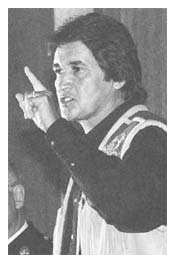
Ovide Mercredi |
These processes are not without their difficulties, as the "Indian
Summer" of 1990 at Oka and the still unsettled 50-year Lubicon
land dispute in northern Alberta illustrate. Ovide Mercredi,
Grand Chief of the Assembly of First Nations, believes that
agreements should be negotiated with chiefs from coast to coast
working together on a national scale. Many of the chiefs are
not in accord; they prefer a regional approach, such as that
taken by the Assembly of Manitoba Chiefs, which already has
a preliminary self-government agreement for that province.
The one certain thing in this developing process is that Canada's
Aboriginal peoples will have a much higher profile in the nation's
affairs in the future than has been the case since Confederation.
The goals of self-determination and renewal of communal identity
are challenging ones for Native people who live in a modern
world where remarkable changes have transpired in technology,
environment and culture. Successfully adapting what they can
use to their benefit, while nurturing those traditions that
they hold dear will undoubtedly play a part in achieving these
goals. (As
this article dates back to 1997, some of the most recent developments
are not reflected in here)
|
|